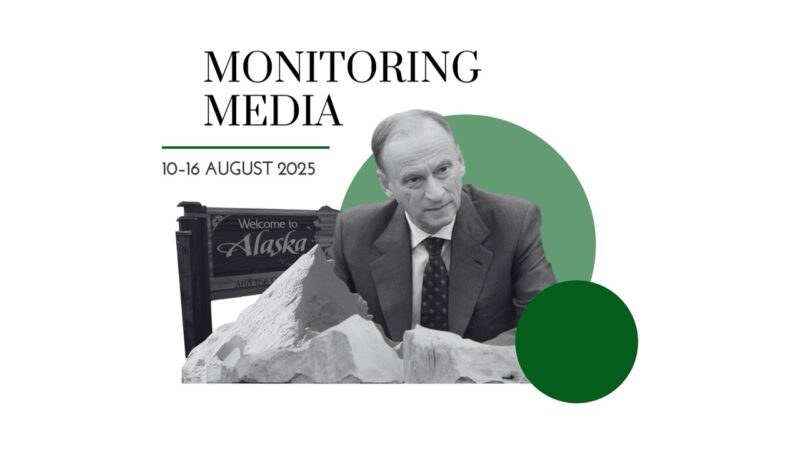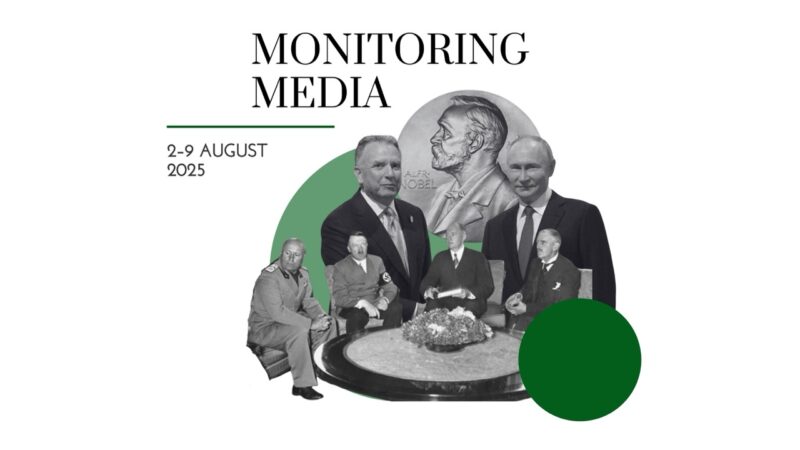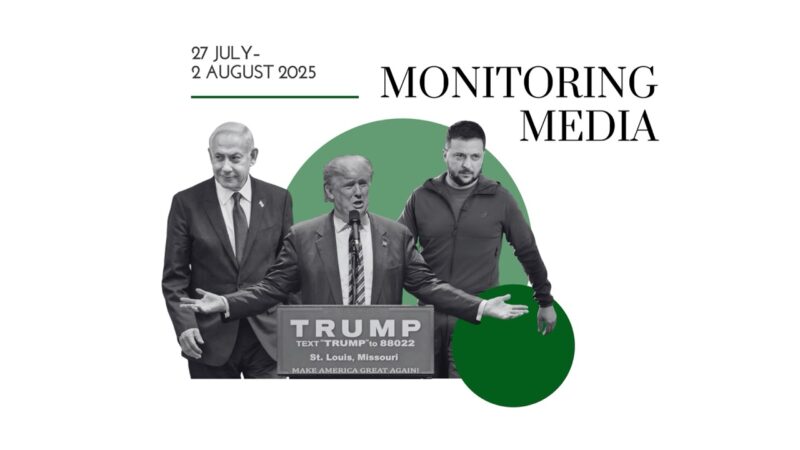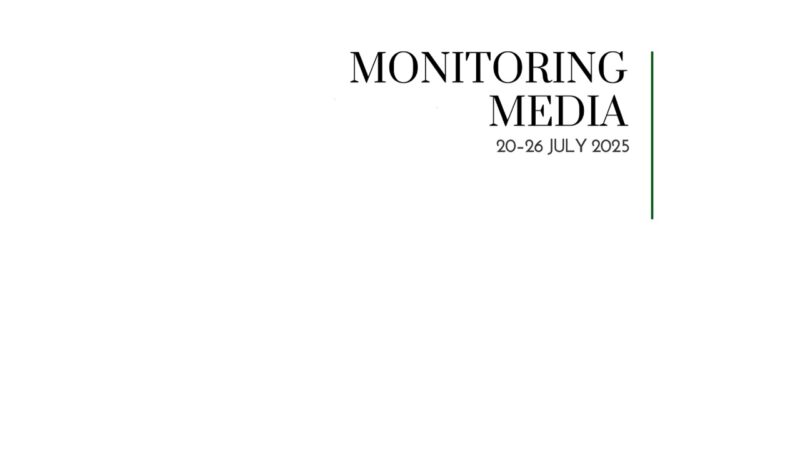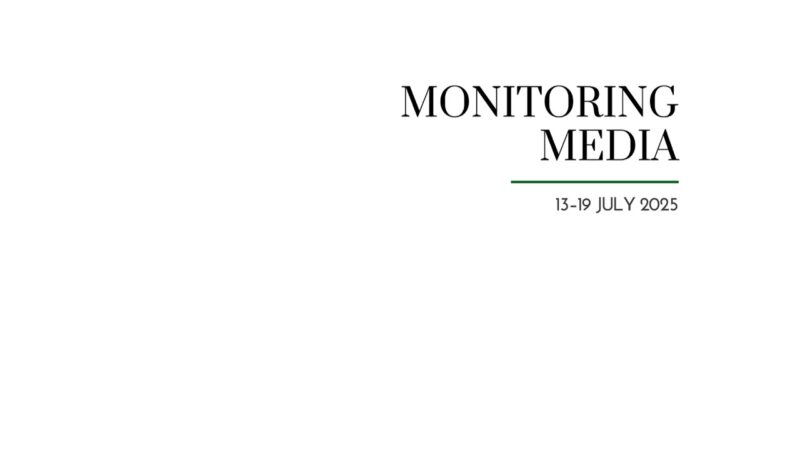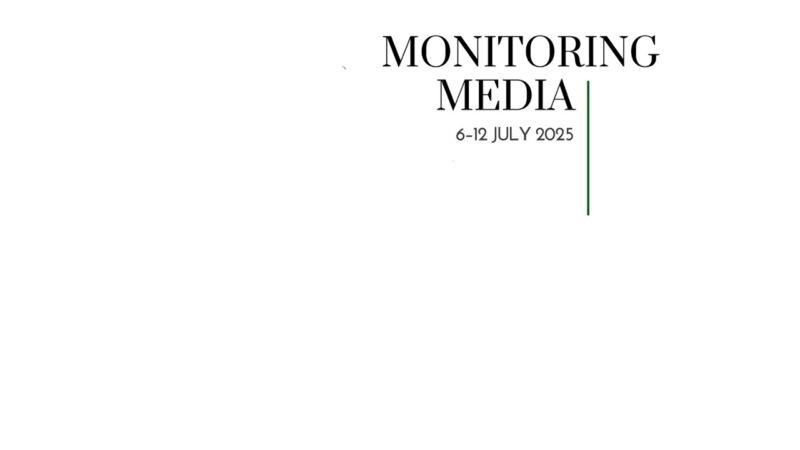Ukraine’s environment another major victim of the Russian invasion

CIUS weekly report on media coverage of Ukrainian affairs, 7–13 January 2023
Three publications (Foreign Policy, Foreign Affairs, and The Economist) were selected to prepare this report on how the situation in Ukraine has been portrayed in the press during the past week (7–13 January 2023). The sample was compiled based on their impact on public opinion as well as on their professional reputation, popularity among the readership, and topical relevance. These three publications represent centrist and conservative viewpoints on the political spectrum.
This report covers only the most-read and relevant articles about Ukraine, as ranked by the respective publications themselves in the past week. Its scope covers promoted articles on home pages and articles from special sections on Ukraine, with the hashtag #Ukraine,
from the paper editions of the publications, and about Ukraine from opinion columns and editorials.
Topics featured in the selected articles:
- Ukraine’s current affairs: Ukraine needs heavy weaponry to prevent the conflict from freezing; Ukraine’s environment and wildlife heavily damaged by military actions;
- The world and Ukraine: Turkey believed to be arming Ukraine with cluster munitions; the West should institute a new long-term containment policy; the West is unimpressed by Russia’s war potential and impressed by Ukraine’s effort; the West should include the probability of Russia’s disintegration while drafting postwar scenarios; if Russo-Ukrainian peace talks started today, they would not lead to long-term stability;
- Russia at war: Kremlin decided to invade Ukraine at least three months before February 2022; Russian socio-political order today can be best described as “wartime Putinism.”
The most common arguments:
Ukraine needs Western tanks and missiles to prevent the hot war from transforming into a frozen conflict. The Economist writes that the pace of the Russo-Ukrainian war has slowed down significantly and no major territorial changes have been recorded since the liberation of Kherson. The war has the potential to enter the stage of a “frozen conflict,” which is a more favourable development for the aggressor. In this light, “it is good news that America, France, and Germany are at last sending more powerful weapons—Bradley Fighting Vehicles, the similar French AMX, and the German Marder. But that is not enough; these are armoured infantry carriers with guns rather than true tanks, which have tougher armour and more powerful cannons. If Ukraine is to continue the work of ejecting Russia from the land that has been stolen, it will need more: heavy tanks and longer-range missiles.” The voices in the West against providing Ukraine with tanks and missiles argue that such a move will make NATO a part of the conflict, as well as that Russia may be instigated into using a tactical nuclear weapon. However, up to now the Kremlin’s “red lines” that the West had crossed—for instance, the membership of Finland and Sweden in NATO—did not in fact provoke an aggressive response. Not to mention that “yielding to Mr. Putin’s nuclear threats today sets up more perilous stand-offs tomorrow.” Therefore, Ukraine needs to obtain heavier weaponry and break the stalemate. Otherwise, a repeat of the 2014 scenario may take place, “when Russia and its proxies grabbed chunks of eastern Ukraine and, after intense fighting died down, the contact line between the two sides froze into something like a frontier.”
The war is disastrous for Ukraine’s environment and wildlife. The Economist begins its discussion of the impact of the war on Ukraine’s environment with the case of a reservoir on the Oskil river, which stretches for about a hundred kilometres south of Kupyansk. Last spring, its floodgates were blown up and the area became swampy and muddy. Last autumn, when Ukrainian forces liberated the area, they saw charred trees and the husks of Russian tanks everywhere. The Economist writes that “forests ravaged by fires caused by relentless shelling or cut down to build trenches; groundwater and soil contaminated by heavy metals and toxic chemicals from detonated munitions; and wild animals killed or driven from their habitat [are] the less talked-about victims of the war in Ukraine.” On top of this, it is impossible to fully estimate the impact of war on Ukraine’s environment, as 18 per cent of its territory still remains occupied. According to data from the Ministry of Environmental Protection and Natural Resources, the combined damage from the war amounts to “more than $46bn, which Ukraine will in time demand as war reparations from Russia … air pollution, at $27bn, accounts for the bulk of the sum.” At the same time, there is a growing expectation in Ukraine that the state’s postwar reconstruction will include modern “green” and renewable industrialization. Much of it has already been accomplished: “over the past year, Ukraine’s forest agency has planted over 180m new trees as part of a reforestation programme.”
Turkey believed to be arming Ukraine with cluster bombs. Jack Detsch and Robbie Gramer (Foreign Policy) open their article with the statement that “Turkey began sending Ukraine a form of US-designed, artillery-fired cluster bomb in late 2022 after months of Kyiv pleading with the Biden administration for the munitions … giving Kyiv a powerful—but controversial—weapon to destroy Russian tanks and kill troops on the battlefield.” Detsch and Gramer highlight that Turkey has skillfully “played on two fields” since February 2022: on the one hand, it provided Ukraine with Bayraktar TB2 drones which were used to defend Kyiv, as well as brokered the export of Ukrainian grain from Odesa; on the other hand, it continued purchasing weapons from Russia and selectively applied Western sanctions, which angered its allies in NATO. Today, Turkey has decided to equip Ukraine with cluster munitions “which were made during the Cold War era under a co-production agreement with the United States.” These munitions are believed to be 20 times as effective as comparable artillery rounds. Some advocates in the US had appealed to Washington to send cluster bombs to Ukraine much earlier; however, the US has not been known to export such munitions for years. Furthermore, the US has been a major proponent of getting rid of cluster bombs worldwide. On the other hand, Turkey is not bound by any such strict obligations, nor is it a member of the Convention on Cluster Munitions. Detsch and Gramer conclude that Ukraine’s use of cluster bombs may be a proverbial double-edged sword: “Unlike traditional landmines, cluster munitions aren’t often neatly planted in rows that can be easily surveyed and cleared. Rather, they scatter more randomly when fired and have a high dud rate. Experts worry that because of its small size, akin to a D-cell battery, they are too unsafe to destroy en masse, and innocent civilians could mistakenly pick them up.”
That being said, in his other article Jack Detsch (Foreign Policy) writes that the Pentagon is contemplating sending Ukraine small precision-guided bombs (GLSDB) that would allow Kyiv to strike Russian targets nearly 100 miles away, including in the Russian mainland. However, it remains unclear when and in what configuration Ukraine would receive this weaponry. Detsch raises the concern that the delays may be significant and that GLSDB will have a limited effect on Ukraine’s war effort.
The West needs to be ready for a protracted conflict and develop a policy for Russia’s containment. Ivo H. Daalder and James Goldgeier (Foreign Affairs) argue that the Russo-Ukrainian war will not end soon, as both belligerents are determined to achieve their objectives. Thus, there is no room yet for genuine peace talks; resources for active fighting are becoming scarce (which will gradually lessen the intensity of the fighting), and any new advancements on either side will take place at a great cost. Therefore, “rather than assuming that the war can be ended through triumph or talks, the West needs to contemplate a world in which the conflict continues with neither victory nor peace in sight.” Daalder and Goldgeier continue that “the United States and its allies will need to continue providing Ukraine with military support to defend against further Russian aggression. They will need to contain Russia’s larger ambitions by maintaining economic sanctions and isolating Moscow diplomatically. And they will need to ensure that the conflict does not escalate. At the same time, they will need to lay a long-term basis for security and stability in Europe. That will require integrating Ukraine fully into the West while forging a containment policy that emphasizes both deterrence of Russian aggression and efforts to engage Moscow to avoid the escalation of the war to a broader military confrontation that no one wants.” They argue that the West needs to develop a comprehensive policy toward Kyiv and the Kremlin that incorporates the possibility of a protracted conflict, which may become a sort of frozen one even if Putin gets replaced. That being said, as in the Cold War times, a communication channel between Western capitals, Kyiv, and the Kremlin should always exist in order to be able to discuss strategic issues of interest to all parties (e.g., prisoner exchanges or proliferation of weapons of mass destruction).
The West did not expect Ukraine’s effectiveness or Russian underperformance in this war. Ravi Agrawal (Foreign Policy) interviews David Petraeus (a retired four-star general who led US operations in Iraq and Afghanistan) and Anne-Marie Slaughter (a former director of policy planning in the US State Department) on the Russo-Ukrainian war. The interviewees highlight the following points in their answers. First, the major surprises of the war have been the proficiency of the Ukrainian leadership, who managed to “get the big ideas right, communicate them effectively, oversee their implementation, and determine how to refine them”; the sheer incompetence of the Russians, who failed to design and conduct a successful military campaign, especially considering the abundance of time and weaponry they possessed; and the rather mild reaction to the war from democratic India and Brazil, whose non-alignment with the general Western position may signal “a much bigger shift in the global order than most American and European analysts give credit for.” Secondly, the ongoing Russo-Ukrainian war “is not the war of the future [but] more of a throwback to the Cold War turning hot”; the wars of the future will be more technological and engage massive numbers of unmanned piloted vehicles. Thirdly, China’s relations with Russia have become uncomfortable and awkward; therefore, the West needs to develop a nuanced strategy for Beijing and further discourage it from cooperating with the Kremlin. Fourthly, Russian cyber-attacks on Ukraine failed because the defending side received aid from the West and proved to be much more resilient than the Kremlin expected. Finally, the prolonged sanctions against Russia are not only harming the economies of the EU but also discouraging developing states from deeper integration into Western financial systems.
The West should not push Ukraine into peace talks with Russia, as no desirable outcomes will follow. James K. Sebenius and Michael Singh (Foreign Affairs) criticize the position of “progressive” Democrats in the US Congress as well as other political voices in the US that are calling for peace talks between Ukraine and Russia. Sebenius and Singh highlight that not holding talks now should be regarded as a tactic for achieving a desired objective. That is, peace talks between Ukraine and Russia go against the logic of the present momentum: “no deal is possible between a Ukraine that is making steady battlefield progress and a Russia in denial of this reality. Even calling for talks today risks benefiting Moscow.” The push for talks will not serve the US national interest either. To support their position, Sebenius and Singh argue that there exists no “zone of possible agreement” (ZOPA) between belligerents—“that is, the difference between the absolute maximum that one side could offer and the absolute minimum that the other could accept.” On the one hand, the government in Kyiv is investing resources in liberating all parts of the occupied Ukrainian territory, including Donbas and Crimea. On the other hand, the Kremlin promises to continue the war up to the moment when all of Ukraine falls to invading troops and resistance is fully overcome. Sebenius and Singh posit that “to open up a ZOPA that contains feasible and desirable deals, Russia’s [bargaining position] must deteriorate, militarily and otherwise, so that Moscow will agree to settle for less. At the same time, the [bargaining position] of Ukraine and the West…ideally should improve—militarily, economically, and otherwise—so that Kyiv does not feel pressure to entertain bad deals.” In this light, Sebenius and Singh conclude that Ukraine should keep on winning on the battlefield and, thus, weaken Russia’s bargaining position, while the US and EU “must, paradoxically, convince Moscow of their commitment to enabling Ukrainian soldiers to expel Russian troops by force and redoubling other penalties on Russia’s aggression.”
The West should be ready that Russia’s defeat in its war in Ukraine may instigate the federation’s collapse. Alexander J. Motyl (Foreign Policy) argues that the West should start seriously working on its response to a plausible scenario of Russia’s disintegration into smaller sovereign entities following its defeat in the war: “a weakened regime, in conjunction with a malfunctioning economy, will invite disgruntled Russians to take to the streets, perhaps even with arms, and encourage some of the non-Russian political units comprising the Russian Federation to opt for greater self-rule; leading candidates include Tatarstan, Bashkortostan, Chechnya, Dagestan, and Sakha. If Russia survives this turmoil [intact], it’s likely to become a weak client state of China. If it does not, the map of Eurasia could look very different.” Motyl argues that the disintegration scenario should not be downplayed in the West, because empires of the past often crumbled after defeats in wars or system breakdowns; the Russian empire and, later, the USSR have a separate record of disintegrations. Motyl also highlights that contemporary Russia has accumulated numerous social-political problems, such as the inflexibility of a centralized system of governance and omnipresent corruption, that may provide fuel to nationwide acts of non-conformism once the right opportunity appears. The disintegration of Russia, if it happens, may lead to two outcomes: a series of civil wars on the huge Eurasian territory (pessimistic scenario), or a comparatively peaceful separation of national republics (optimistic scenario). The history of empires provides evidence that both scenarios are possible. In any case, as Motyl concludes, “the West should avoid repeating past mistakes, such as trying to help a clearly dying Soviet Union survive and prioritizing Russia’s needs over those of its neighbors.”
Russia manifested its clear intent for invasion already in November 2022. Amy Mackinnon and Robbie Gramer (Foreign Policy) interview John Sullivan, a former US ambassador to Russia, about the events of the last year. In his answers, Sullivan highlights the following points. First, at the end of October 2022 Russia started gathering an unprecedented number of troops at the border with Ukraine, and in November Sullivan received two draft treaties on security guarantees which Russians were not willing to discuss—these were powerful signs of a forthcoming invasion. Second, the invasion was all scripted, and the Kremlin invested a lot of time in trying to convince the international community that it was itself under threat. Third, Putin is not likely to be terminally ill, but he is under a lot of stress and consults on his ideas of aggressive conquest only with his closest inner circle. Fourthly, the US needs to have its ambassador in Russia for immediate communication between Washington and the Kremlin, even though the embassy is operating under numerous Kremlin-imposed constraints.
Russian social-political order can be best described today as “wartime Putinism.” Michael Kimmage and Maria Lipman (Foreign Affairs) analyze the repercussions of the disastrous invasion of Ukraine for the Kremlin’s rule and the Russian state. They say that Putin’s and the Kremlin’s policies have largely been reactionist since February 2022: failing to win a quick war, “the Russian president has instead focused on militarizing the state and the public sphere, purging those who openly dissent from the government’s position on the war, and stoking militant anti-Westernism among the wide swaths of the public that are, if not pro-war, at least genuinely anti-antiwar.” Kimmage and Lipman continue that “the price of not winning a war [for Russia] is a panoply of negative objectives: not losing, not giving up, not admitting defeat, not allowing anything to threaten the survival of the regime.” They call such panoply a “wartime Putinism” that has normalized perception of war in the society, legitimized repressions and violations of human rights, as well as forced the Russian middle class to adjust to the sanctions. The society had become full of war believers, who associated the successful performance of the Russian army with Putin’s leadership. However, “wartime Putinism” is an empty policy in the long run, an attempt to defer problems that will be offering society only diminishing returns. This policy also requires acquiescence but not passionate support of the invasion, because the latter may stir the society into resenting the regime that demonstrates little progress on the battlefield. Therefore, by announcing the second wave of mobilization and meddling with social feelings, Putin and the Kremlin are stepping on a tightrope.
